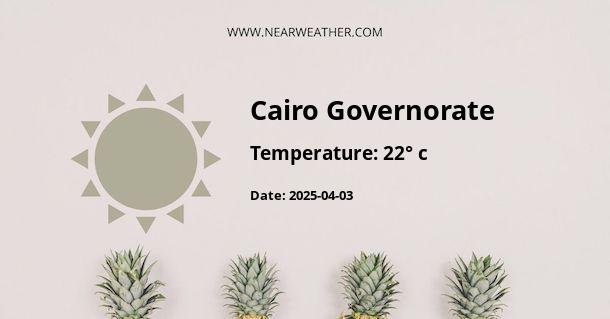Climate and Weather in Muḩāfaz̧at al Qāhirah, Egypt
Muḩāfaz̧at al Qāhirah, commonly known as Cairo, is the capital and largest city of Egypt. Located on the banks of the Nile River, Cairo experiences a hot desert climate. The city's weather is influenced by its proximity to the Sahara Desert and the Mediterranean Sea.
Temperature
Cairo has a typical desert climate with hot and dry summers and mild winters. The average annual temperature in Cairo ranges from 20°C (68°F) to 27°C (81°F). Summers are extremely hot, with temperatures often exceeding 40°C (104°F) during the day. The highest recorded temperature in Cairo was 46°C (115°F).
Although winters in Cairo are mild, temperatures can drop to around 10°C (50°F) during the coldest months of December and January. However, it is important to note that Cairo experiences significant temperature fluctuations between day and night, with daytime temperatures being much warmer than nighttime temperatures.
Precipitation
Cairo has a very low annual precipitation, with most of the rain falling during the winter months. The city receives an average of only 25mm (1 inch) of rainfall per year, making it one of the driest major cities in the world. The majority of the precipitation occurs between October and March, with December being the wettest month.
Despite the low rainfall, Cairo experiences occasional heavy downpours, which can cause localized flooding due to the city's inadequate drainage system. These heavy rains are often accompanied by thunderstorms.
Humidity
Cairo has relatively low humidity levels, especially during the summer months. The city's proximity to the desert contributes to the dry air. The average relative humidity in Cairo ranges from 40% to 60%. However, during the winter months, humidity levels can increase slightly due to the influence of the Mediterranean Sea.
Sandstorms
Due to its location near the Sahara Desert, Cairo is occasionally affected by sandstorms. These sandstorms, also known as haboobs, occur when strong winds carry fine particles of sand and dust from the desert into the city. Sandstorms can lead to reduced visibility and have a significant impact on air quality.
Climate Chart
| Month | Mean Temperature (°C) | Mean Precipitation (mm) |
|---|---|---|
| January | 13 | 5 |
| February | 14 | 3 |
| March | 17 | 4 |
| April | 21 | 2 |
| May | 25 | 1 |
| June | 27 | 0 |
| July | 28 | 0 |
| August | 28 | 0 |
| September | 26 | 0 |
| October | 23 | 1 |
| November | 18 | 3 |
| December | 14 | 6 |
Best Time to Visit
The best time to visit Cairo is during the cooler months of October to April when temperatures are more comfortable for outdoor activities. The spring (March to May) and autumn (September to November) months offer pleasant weather with mild temperatures.
It is important to note that Cairo can be crowded with tourists during the peak season, especially during major holidays. If you prefer to avoid the crowds, consider visiting during the shoulder seasons.
Conclusion
Cairo experiences a hot desert climate, characterized by scorching summers and mild winters. The city's low annual precipitation and low humidity levels contribute to its arid environment. Sandstorms can occasionally occur due to the city's proximity to the Sahara Desert. If you plan to visit Cairo, it is advisable to choose the cooler months for a more comfortable experience.
A - Cairo Governorate's Latitude is 30.049999 & Longitude is 31.650000.
A - Weather in Cairo Governorate is 22° today.
A - Climate Conditions in Cairo Governorate shows clear sky today.
A - Humidity in Cairo Governorate is 44% today.
A - Wind speed in Cairo Governorate is 15.59 km/h, flowing at 75° wind direction. today.
